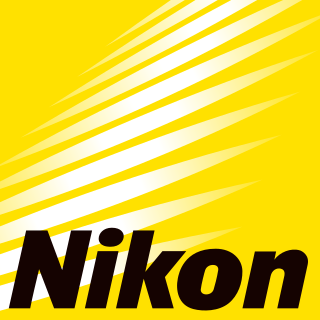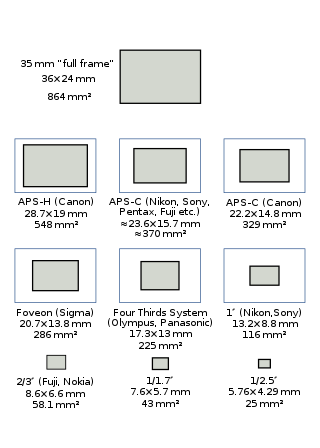
Nikon Corporation is a Japanese optics and photographic equipment manufacturer. Nikon's products include cameras, camera lenses, binoculars, microscopes, ophthalmic lenses, measurement instruments, rifle scopes, spotting scopes, and equipment related to semiconductor fabrication, such as steppers used in the photolithography steps of such manufacturing. Nikon is the world's second largest manufacturer of such equipment.

A digital single-lens reflex camera is a digital camera that combines the optics and mechanisms of a single-lens reflex camera with a solid-state image sensor and digitally records the images from the sensor.

Sigma Corporation is a Japanese company, manufacturing cameras, lenses, flashes and other photographic accessories. All Sigma products are produced in the company's own Aizu factory in Bandai, Fukushima, Japan. Although Sigma produces several camera models, the company is best known for producing high-quality lenses and other accessories that are compatible with the cameras produced by other companies.

Advanced Photo System type-C (APS-C) is an image sensor format approximately equivalent in size to the Advanced Photo System film negative in its C ("Classic") format, of 25.1×16.7 mm, an aspect ratio of 3:2 and Ø 30.15 mm field diameter. It is therefore also equivalent in size to the Super 35 motion picture film format, which has the dimensions of 24.89 mm × 18.66 mm and Ø 31.11 mm field diameter.

A full-frame DSLR is a digital single-lens reflex camera (DSLR) with a 35 mm image sensor format. Historically, 35 mm was one of the standard film formats, alongside larger ones, such as medium format and large format. The full-frame DSLR is in contrast to full-frame mirrorless interchangeable-lens cameras, and DSLR and mirrorless cameras with smaller sensors, much smaller than a full 35 mm frame. Many digital cameras, both compact and SLR models, use a smaller-than-35 mm frame as it is easier and cheaper to manufacture imaging sensors at a smaller size. Historically, the earliest digital SLR models, such as the Nikon NASA F4 or Kodak DCS 100, also used a smaller sensor.

Image stabilization (IS) is a family of techniques that reduce blurring associated with the motion of a camera or other imaging device during exposure.

In digital photography, the image sensor format is the shape and size of the image sensor.

This article details lensesfor single-lens reflex and digital single-lens reflex cameras. The emphasis is on modern lenses for 35 mm film SLRs and for "full-frame" DSLRs with sensor sizes less than or equal to 35 mm.

The Micro Four Thirds system is a standard released by Olympus Imaging Corporation and Panasonic in 2008, for the design and development of mirrorless interchangeable lens digital cameras, camcorders and lenses. Camera bodies are available from Blackmagic, DJI, JVC, Kodak, Olympus, OM System, Panasonic, Sharp, Logitech Mevo and Xiaomi. MFT lenses are produced by Cosina Voigtländer, Kowa, Kodak, Mitakon, Olympus, Panasonic, Samyang, Sharp, Sigma, SLR Magic, Tamron, Tokina, TTArtisan, Veydra, Xiaomi, Laowa, Yongnuo, Zonlai, Lensbaby, Venus Optics and 7artisans amongst others.

A mirrorless camera is a digital camera which, in contrast to DSLRs, does not use a mirror in order to ensure that the image presented to the photographer through the viewfinder is identical to that taken by the camera. They have come to replace DSLRs, which have historically dominated interchangeable lens cameras. Other terms include electronic viewfinder interchangeable lens (EVIL) cameras and compact system cameras (CSCs).

The Canon EOS 600D is an 18.0 megapixel digital single-lens reflex camera, released by Canon on 7 February 2011. It is known as the EOS Kiss X5 in Japan and the EOS Rebel T3i in America. The 600D is the second Canon EOS camera with an articulating LCD screen and supersedes the 550D, although the earlier model was not discontinued until June 2012, when the successor of the 600D, the 650D, was announced.
The Pentax Q series is a series of mirrorless interchangeable-lens cameras made by Pentax and introduced in 2011 with the initial model Pentax Q. As of September 2012, it was the world's smallest, lightest interchangeable lens digital camera. The first models used a 1/2.3" back-illuminated sensor CMOS image sensor. The Q7, introduced in June 2013, uses a larger 1/1.7" type sensor. The Q system is now discontinued.

The Nikon 1 series is a discontinued camera line from Nikon, originally announced on 21 September 2011. The cameras utilized Nikon 1-mount lenses, and featured 1" CX format sensors.

The Sony α NEX-7 is a digital camera announced 24 August 2011 by Sony. It is a mirrorless interchangeable lens camera and as such inherits a smaller body form factor than a traditional digital single-lens reflex camera, while still retaining the sensor size and features of an APS-C-sized model. It is targeted at experienced users, enthusiasts and professionals. It is replaced by the ILCE-6000 (α6000).

The Sony α7, α7R, α7S and α7C are four closely related families of full-frame mirrorless interchangeable-lens cameras. The first two were announced in October 2013, the third in April 2014 and the fourth in September 2020. They are Sony's first full-frame mirrorless interchangeable lens cameras and share the E-mount with the company's smaller sensor NEX series.

Nikon Z-mount is an interchangeable lens mount developed by Nikon for its mirrorless digital cameras. In late 2018, Nikon released two cameras that use this mount, the full-frame Nikon Z7 and Nikon Z6. In late 2019 Nikon announced their first Z-mount camera with an APS-C sensor, the Nikon Z50. In July 2020 the entry-level full-frame Z5 was introduced. In October 2020, Nikon announced the Nikon Z6II and Nikon Z7II, which succeed the Z6 and Z7, respectively. The APS-C lineup was expanded in July 2021, with the introduction of the retro styled Nikon Zfc, and in October 2021, Nikon unveiled the Nikon Z9, which effectively succeeds the brand's flagship D6 DSLR. The APS-C lineup was further expanded with the Nikon Z30, announced at the end of June 2022. The Nikon Z6III was announced in June 2024. In November 2024, Nikon announced the Z50II, the first APS-C camera to use the Expeed 7 processor introduced with the Z9.

The Nikon Z7 is a 45.7 megapixel full-frame mirrorless interchangeable-lens camera produced by Nikon. The camera was officially announced on August 23, 2018, for release in September 2018. It was the first camera to use Nikon's new Z-mount system; the second model, released in November 2018, was the 24.5 megapixel Nikon Z 6.

The Nikon Z6 is a full-frame mirrorless interchangeable-lens camera produced by Nikon. The camera was officially announced on August 23, 2018, to be released in November. Nikon began shipping the Z6 to retailers on November 16, 2018. This was the second camera to use Nikon's new Z-mount system after the release of the 45.75 megapixel Nikon Z7 in September 2018.

The Canon EOS R is the first full-frame mirrorless interchangeable-lens camera (MILC) produced by Canon. It was announced days after Nikon's first full-frame MILC, the Nikon Z 7, and five years after Sony's first, and was released in October 2018. The camera is the first of Canon's new EOS R system, and the first to use the RF lens mount. The "R" stands for "Reimagine optical excellence".

The Z30 is an APS-C mirrorless camera announced by Nikon on June 29, 2022. It is the ninth Z-mount camera body and the third APS-C Z-mount body. The Z30 is the first Z-mount camera body which does not have a built-in viewfinder. The camera yields a 20.9-megapixel still image and 4K video, however it does not have In-Body Image Stabilisation (IBIS).























